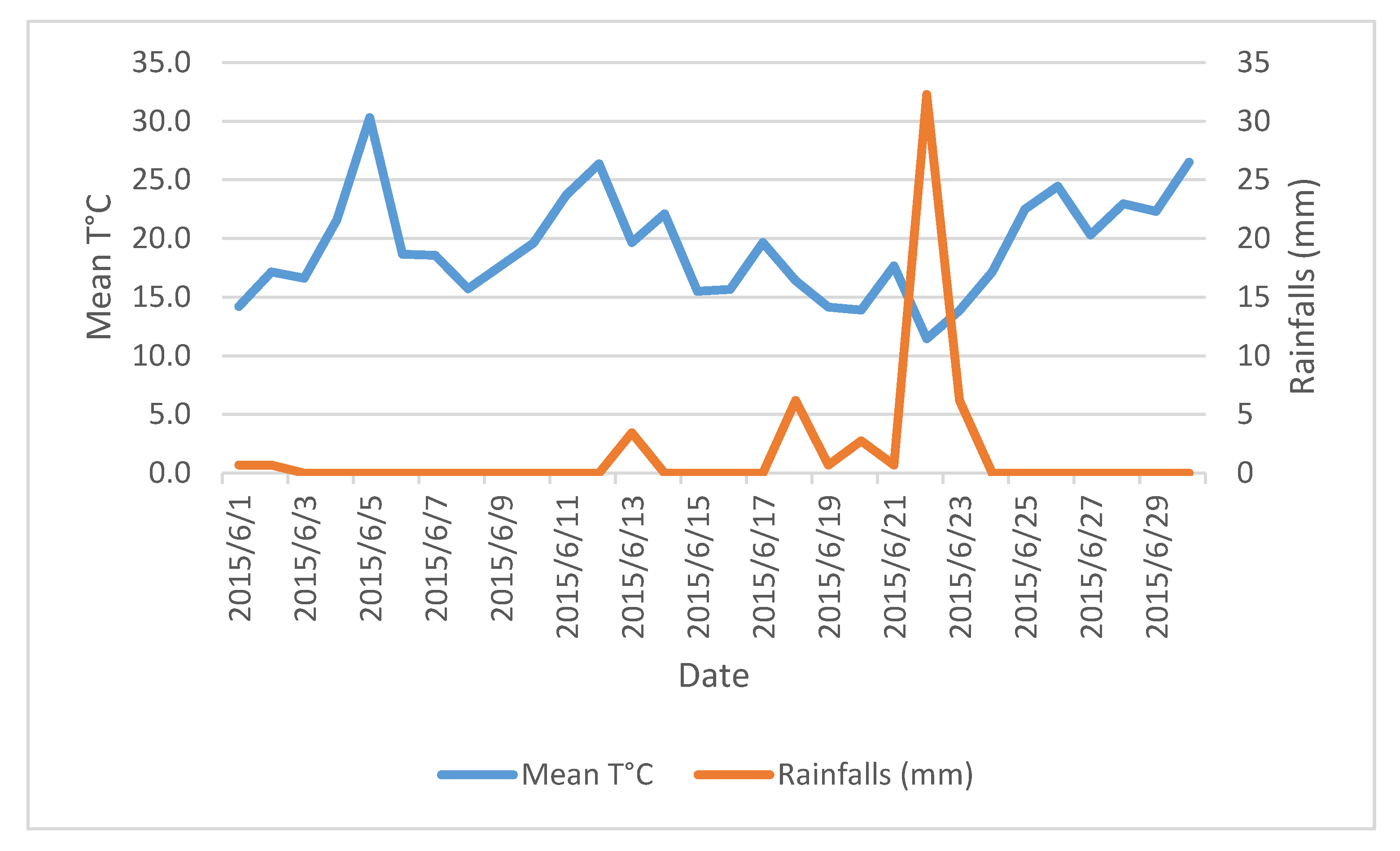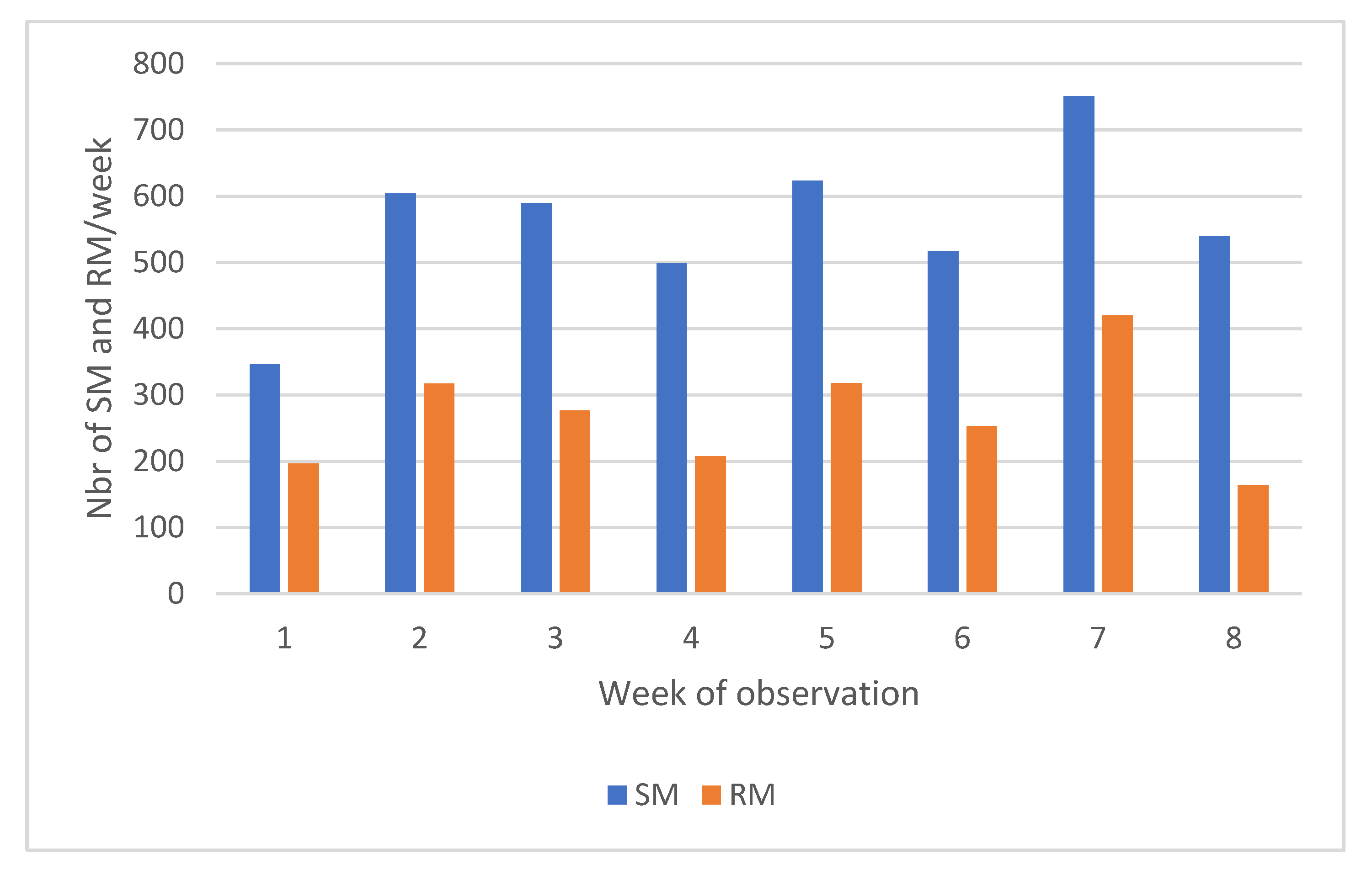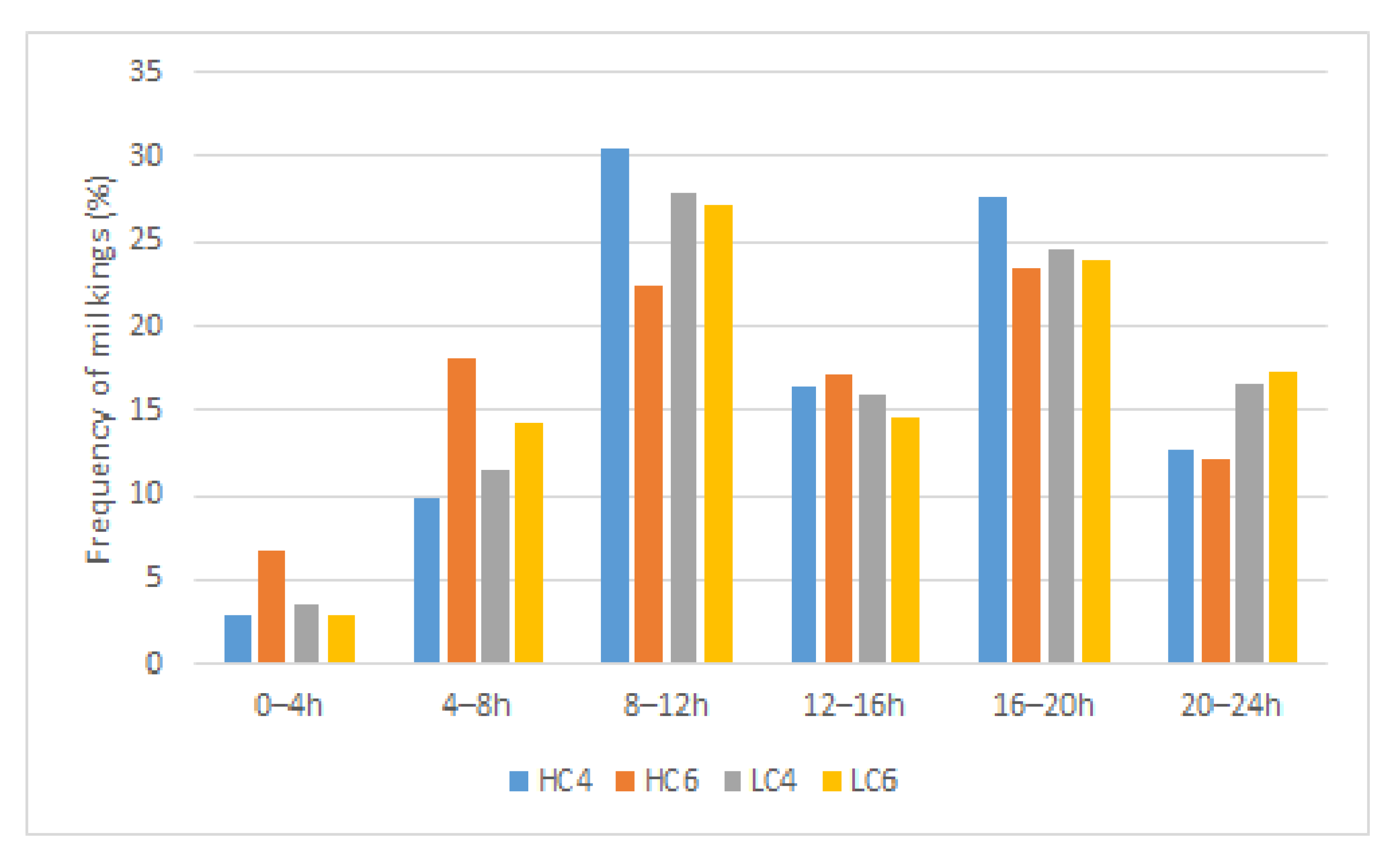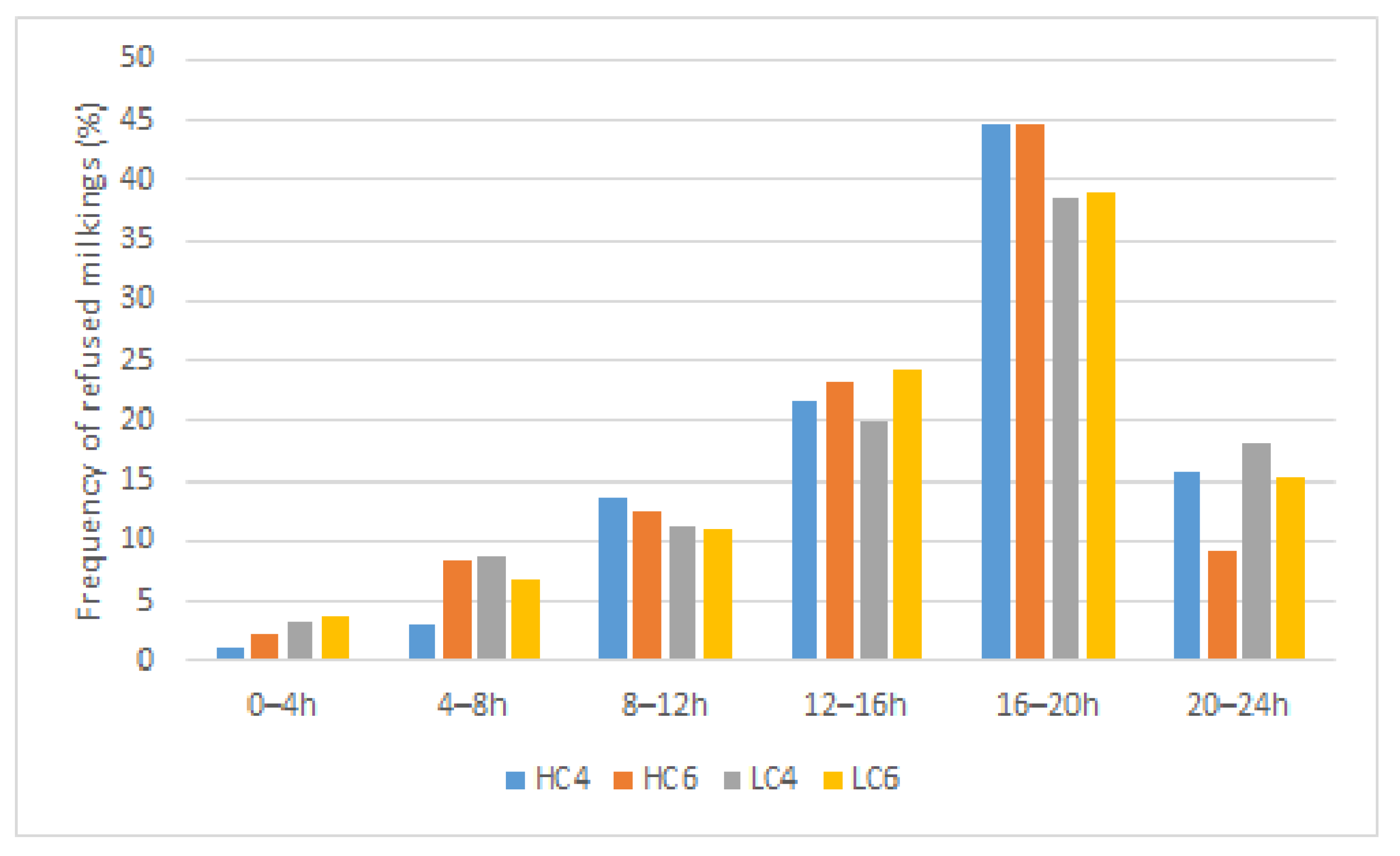Effect of Minimum Milking Interval on Traffic and Milk Production of Cows Milked by a Pasture Based Automatic Milking System
Abstract
Simple Summary
Abstract
1. Introduction
2. Materials and Methods
2.1. Animals and Experimental Design
2.2. Grazing Management
2.3. Statistical Analysis
3. Results
3.1. Grazing Management
3.2. Zootechnical Performance
3.3. Voluntary Cows Traffic to the Robot
3.4. Analysis of Contingency Tables
3.5. Effect of Parity
4. Discussion
5. Conclusions
Author Contributions
Funding
Institutional Review Board Statement
Conflicts of Interest
References
- Cogato, A.; Brščić, M.; Guo, H.; Marinello, F.; Pezzuolo, A. Challenges and Tendencies of Automatic Milking Systems (AMS): A 20-Years Systematic Review of Literature and Patents. Animals 2021, 11, 356. [Google Scholar] [CrossRef]
- Gargiulo, J.I.; Eastwood, C.R.; Garcia, S.C.; Lyons, N.A. Dairy Farmers with Larger Herd Sizes Adopt More Precision Dairy Technologies. J. Dairy Sci. 2018, 101, 5466–5473. [Google Scholar] [CrossRef]
- Dillon, P.; Roche, J.R.; Shalloo, L.; Oran, B. Optimising Financial Return from Grazing in Temperate Pastures. Utilisation of grazed grass in temperate animal systems. In Proceedings of the a Satellite Workshop of the XXth International Grassland Congress, Cork, Ireland, 26 June–1 July 2005; pp. 131–147. [Google Scholar]
- Lessire, F.; Scohier, C.; Dufrasne, I. Impact of Grazing Practices on Farm Self-Sufficiency, Milk and Economic Performances of Three Automatized Farms. In Proceedings of the 19th Symposium of the European Grassland Federation, Alghero, Italy, 7–10 May 2017; pp. 182–184. [Google Scholar]
- Watt, L.J.; Clark, C.E.F.; Albornoz, R.I.; Krebs, G.L.; Petzel, C.E.; Utsumi, S.A. Effects of Grain-Based Concentrate Feeding and Rumination Frequency on the Milk Production, Methane and Carbon Dioxide Fluxes, and Activity of Dairy Cows in a Pasture-Based Automatic Milking System. Livest. Sci. 2021, 245, 104420. [Google Scholar] [CrossRef]
- de Olde, E.M.; Oudshoorn, F.W.; Sørensen, C.A.G.; Bokkers, E.A.M.; de Boer, I.J.M. Assessing Sustainability at Farm-Level: Lessons Learned from a Comparison of Tools in Practice. Ecol. Indic. 2016, 66, 391–404. [Google Scholar] [CrossRef]
- Naspetti, S.; Mandolesi, S.; Buysse, J.; Latvala, T.; Nicholas, P.; Padel, S.; Van Loo, E.J.; Zanoli, R. Consumer Perception of Sustainable Practices in Dairy Production. Agric. Food Econ. 2021, 9, 1. [Google Scholar] [CrossRef]
- Brocard, V.; Lessire, F.; Cloet, E.; Huneau, T.; Dufrasne, I.; Déprés, C. Diverse Ways to Combine Grazing and Automatic Milking Systems. Fourrages 2017, 229, 17–24. [Google Scholar]
- Lyons, N.A.A.; Kerrisk, K.L.L.; Garcia, S.C.C. Milking Frequency Management in Pasture-Based Automatic Milking Systems: A Review. Livest. Sci. 2014, 159, 102–116. [Google Scholar] [CrossRef]
- Lyons, N.A.; Kerrisk, K.L.; Garcia, S.C. Comparison of 2 Systems of Pasture Allocation on Milking Intervals and Total Daily Milk Yield of Dairy Cows in a Pasture-Based Automatic Milking System. J. Dairy Sci. 2013, 96, 4494–4504. [Google Scholar] [CrossRef]
- O’Brien, B.; Foley, C.; Danilo, S.; Huneau, T.; François, J.; Cloët, E.; Bertrand, S.; Lessire, F.; Dufrasne, I.; Oudshoorn, F.W.; et al. Optimizing Pasture Proportion in Cow Diet in Association with Automatic Milking–Guidelines for Different Countries and Production Systems, 2015.
- Cloet, E.; Brocard, V.; Lessire, F.; Guiocheau, S. Maximizing Grazing with a Mobile Milking Robot. In Proceedings of the 8th European Precision Livestock Farming, Nantes, France, 14–17 September 2017; pp. 28–34. [Google Scholar]
- Lyons, N.A.; Kerrisk, K.L.; Dhand, N.K.; Garcia, S.C. Factors Associated with Extended Milking Intervals in a Pasture-Based Automatic Milking System. Livest. Sci. 2013, 158, 179–188. [Google Scholar] [CrossRef]
- Lessire, F.; Froidmont, E.; Shortall, J.; Hornick, J.-L.; Dufrasne, I. The Effect of Concentrate Allocation on Traffic and Milk Production of Pasture Based Cows Milked by an Automatic Milking System. Animal 2017, 11, 2061–2069. [Google Scholar] [CrossRef]
- De Boever, J.L.; Vanacker, J.M.; Fiems, L.O.; De Brabander, D.L. Rumen Degradation Characteristics and Protein Value of Grassland Products and Their Prediction by Laboratory Measurements and NIRS. Anim. Feed. Sci. Technol. 2004, 116, 53–66. [Google Scholar] [CrossRef]
- Bernabucci, U.; Biffani, S.; Buggiotti, L.; Vitali, A.; Lacetera, N.; Nardone, A. The Effects of Heat Stress in Italian Holstein Dairy Cattle. J. Dairy Sci. 2014, 97, 471–486. [Google Scholar] [CrossRef]
- Ouellet, V.; Cabrera, V.E.; Fadul-Pacheco, L.; Charbonneau, É. The Relationship between the Number of Consecutive Days with Heat Stress and Milk Production of Holstein Dairy Cows Raised in a Humid Continental Climate. J. Dairy Sci. 2019, 102, 8537–8545. [Google Scholar] [CrossRef]
- Sharpe, D. Chi Square Test Is Statistically Significant: Now What? Pract. Assess. Res. Eval. 2015, 20, 8. [Google Scholar] [CrossRef]
- Delaby, L.; Peyraud, J.L.; Delagarde, R. Effect of the Level of Concentrate Supplementation, Herbage Allowance and Milk Yield at Turn-out on the Performance of Dairy Cows in Mid Lactation at Grazing. Anim. Sci. 2001, 73, 171–181. [Google Scholar] [CrossRef]
- Shortall, J.; Foley, C.; Sleator, R.D.; O’Brien, B. The Effect of Concentrate Supplementation on Milk Production and Cow Traffic in Early and Late Lactation in a Pasture-Based Automatic Milking System. Animal 2017, 12, 853–863. [Google Scholar] [CrossRef]
- McKay, Z.C.; Lynch, M.B.; Mulligan, F.J.; Rajauria, G.; Miller, C.; Pierce, K.M. The Effect of Concentrate Supplementation Type on Milk Production, Dry Matter Intake, Rumen Fermentation, and Nitrogen Excretion in Late-Lactation, Spring-Calving Grazing Dairy Cows. J. Dairy Sci. 2019, 102, 5042–5053. [Google Scholar] [CrossRef]
- Scott, V.E.E.; Kerrisk, K.L.K.L.; Thomson, P.C.C.P.C.; Lyons, N.A.A.; Garcia, S.C.C.S.C.; Wredle, E.; Munksgaard, L.; Spörndly, E.; Witaifi, A.A.; Ali, A.B.A.; et al. Voluntary Cow Traffic and Behaviour in the Premilking Yard of a Pasture-Based Automatic Milking System with a Feed Supplementation Regime. Livest. Sci. 2015, 171, 52–63. [Google Scholar] [CrossRef]
- Jago, J.G.; Davis, K.L.; Copeman, P.J.; Ohnstad, I.; Woolford, M.M. Supplementary Feeding at Milking and Minimum Milking Interval Effects on Cow Traffic and Milking Performance in a Pasture-Based Automatic Milking System. J. Dairy Res. 2007, 74, 492–499. [Google Scholar] [CrossRef]
- Foley, C.; Shortall, J.; O’Brien, B. Milk Production, Cow Traffic and Milking Duration at Different Milking Frequencies in an Automated Milking System Integrated with Grazing. In Proceedings of the Precision Livestock Farming, Milan, Italy, 15–18 September 2015; Berckmans, D.M.G., Ed.; ECPLF: Milan, Italy, 2015; Volume 15, pp. 40–47. [Google Scholar]
- Ketelaar- De Lauwere, C.C.C.; Ipema, A.H.H.; Lokhorst, C.; Metz, J.H.M.H.M.; Noordhuizen, J.P.T.M.P.T.M.; Schouten, W.G.P.G.P.; Smits, A.C.C. Effect of Sward Height and Distance between Pasture and Barn on Cows’ Visits to an Automatic Milking System and Other Behaviour. Livest. Prod. Sci. 2000, 65, 131–142. [Google Scholar] [CrossRef]
- Scott, V.E.E.; Thomson, P.C.C.; Kerrisk, K.L.L.; Garcia, S.C.C. Influence of Provision of Concentrate at Milking on Voluntary Cow Traffic in a Pasture-Based Automatic Milking System. J. Dairy Sci. 2014, 97, 1481–1490. [Google Scholar] [CrossRef] [PubMed]
- Penry, J.F.; Crump, P.M.; Hernandez, L.L.; Reinemann, D.J. Association of Milking Interval and Milk Production Rate in an Automatic Milking System. J. Dairy Sci. 2017, 101, 1616–1625. [Google Scholar] [CrossRef] [PubMed]
- Nieman, C.C.; Steensma, K.M.; Rowntree, J.E.; Beede, D.K.; Utsumi, S.A. Differential Response to Stocking Rates and Feeding by Two Genotypes of Holstein-Friesian Cows in a Pasture-Based Automatic Milking System. Animal 2015, 9, 2039–2049. [Google Scholar] [CrossRef] [PubMed][Green Version]
- Van Dooren, H.; Heutinck, L.; Biewenga, G.; Zonderland, J. The Influence of Three Grazing Systems on AMS Performance. In Proceedings of the Automatic Milking: A Better Understanding; Meijering, A., Hogeveen, H., de-Koning, C., Eds.; Wageningen Academic Publishers: Wageningen, The Netherlands, 2004; pp. 292–297. [Google Scholar]
- Spörndly, E.; Wredle, E. Automatic Milking and Grazing—Effects of Distance to Pasture and Level of Supplements on Milk Yield and Cow Behavior. J. Dairy Sci. 2004, 87, 1702–1712. [Google Scholar] [CrossRef]
- John, A.J.; Clark, C.E.F.; Freeman, M.J.; Kerrisk, K.L.; Garcia, S.C.; Halachmi, I. Review: Milking Robot Utilization, a Successful Precision Livestock Farming Evolution. Animal 2016, 10, 1484–1492. [Google Scholar] [CrossRef]
- Charlton, G.L.; Rutter, S.M. The Behaviour of Housed Dairy Cattle with and without Pasture Access: A Review. Appl. Anim. Behav. Sci. 2017, 192, 2–9. [Google Scholar] [CrossRef]
- Ketelaar-de Lauwere, C.C.; Hendriks, M.M.W.B.; Zondag, J.; Ipema, A.H.; Metz, J.H.M.; Noordhuizen, J.P.T.M. Influence of Routing Treatments on Cows’ Visits to an Automatic Milking System, Their Time Budget and Other Behaviour. Acta Agric. Scand. A Anim. Sci. 2000, 50, 174–183. [Google Scholar] [CrossRef]
- Lyons, N.A.; Kerrisk, K.L.; Dhand, N.K.; Scott, V.E.; Garcia, S.C. Animal Behavior and Pasture Depletion in a Pasture-Based Automatic Milking System. Animal 2014, 8, 1506–1515. [Google Scholar] [CrossRef]
- Spörndly, E.; Wredle, E. Automatic Milking and Grazing—Effects of Location of Drinking Water on Water Intake, Milk Yield, and Cow Behavior. J. Dairy Sci. 2005, 88, 1711–1722. [Google Scholar] [CrossRef]
- Lessire, F.; Hornick, J.-L.; Minet, J.; Dufrasne, I. Rumination Time, Milk Yield, Milking Frequency of Grazing Dairy Cows Milked by a Mobile Automatic System during Mild Heat Stress TT–Influence de Périodes de Stress Thermique Modéré Sur Le Temps de Rumination, La Production Laitière et Le Nombre de Trai. Adv. Anim. Biosci. 2015, 6, 12–14. [Google Scholar] [CrossRef]
- Wildridge, A.M.; Thomson, P.C.; Garcia, S.C.; John, A.J.; Jongman, E.C.; Clark, C.E.F.; Kerrisk, K.L. Short Communication: The Effect of Temperature-Humidity Index on Milk Yield and Milking Frequency of Dairy Cows in Pasture-Based Automatic Milking Systems. J. Dairy Sci. 2018, 101, 4479–4482. [Google Scholar] [CrossRef] [PubMed]
- Wildridge, A.M.; Garcia, S.C.; Thomson, P.C.; Jongman, E.C.; Clark, C.E.F.; Kerrisk, K.L. The Impact of a Shaded Pre-Milking Yard on a Pasture-Based Automatic Milking System. Anim. Prod. Sci. 2017, 57, 1219–1225. [Google Scholar] [CrossRef][Green Version]
- Jago, J.; Jackson, A.; Woolford, M. Dominance Effects on the Time Budget and Milking Behaviour of Cows Managed on Pasture and Milked in an Automated Milking System; The New Zealand Society of Animal Production: Queenstown, New Zealand, 2003; Volume 63, pp. 120–123. [Google Scholar]
- Wildridge, A.M.; Thomson, P.C.; Garcia, S.C.; Jongman, E.C.; Clark, C.E.F.; Kerrisk, K.L. The Impact of Fetching at Night on Milking Parlour Visitation for Pasture-Based Dairy Cattle. Appl. Anim. Behav. Sci. 2018, 201, 25–30. [Google Scholar] [CrossRef]
- Halachmi, I. Simulating the Hierarchical Order and Cow Queue Length in an Automatic Milking System. Biosyst. Eng. 2009, 102, 453–460. [Google Scholar] [CrossRef]







| Groups | HC4 | HC6 | LC4 | LC6 |
|---|---|---|---|---|
| DIM (days) | 135 ± 59 | 146 ± 114 | 144 ± 95 | 163 ± 52 |
| LN | 2.6 ± 1.4 | 2.4 ± 1.3 | 2.6 ± 1.7 | 1.9 ± 0.7 |
| Primiparous (n) | 3 | 3 | 4 | 3 |
| MY (kg/cow/day) | 26.9 ± 5.2 | 25.4 ± 7.6 | 25.6 ± 4,5 | 23.8 ±3.4 |
| n | 9 | 10 | 10 | 10 |
| g/kgDM | DM | CP | NDF | ADF | Lignin | WSC | VEM |
|---|---|---|---|---|---|---|---|
| Mean | 210 | 142 | 467 | 245 | 26 | 211 | 967 |
| Std | 38 | 18 | 43 | 28 | 3 | 32 | 48 |
| n | 15 | 15 | 15 | 15 | 15 | 15 | 15 |
| Concentrate Complementation | Low | High | p > F |
|---|---|---|---|
| MY (kg/cow/day) | 19.61 ± 0.94 | 22.54 ± 1.08 | * |
| MY per milking (kg/cow/milking) | 8.31 ± 0.35 | 9.68 ± 0.37 | ** |
| Concentrate (kg/cow/day) | 1.39 ± 0.13 | 3.73 ± 0.14 | *** |
| SM (/cow/day) | 2.17 ± 0.02 | 2.22 ± 0.03 | trend |
| RM (/cow/day) | 1.11 ± 0.04 | 1.04 ± 0.04 | ns |
| FM (/cow/day) | 0.02 ± 0.30 | 0.01 ± 0.20 | ns |
| Visitations (/cow/day) | 3.35 ± 0.02 | 3.33 ± 0.02 | ns |
| Milking interval (h) | 10.82 ± 0.33 | 10.15 ± 0.36 | ns |
| Minimum Milking Interval | 4 h | 6 h | p > F |
|---|---|---|---|
| MY (kg/cow/day) | 21.21 ± 0.94 | 20.94 ± 0.96 | ns |
| MY per milking (kg/cow) | 9.02 ± 0.36 | 8.98 ± 0.36 | ns |
| Concentrate (kg/cow/day) | 2.61 ± 0.13 | 2.51 ± 0.13 | ns |
| SM (/cow/day) | 2.26 ± 0.03 | 2.13 ± 0.02 | * |
| RM (/cow/day) | 0.93 ± 0.04 | 1.23 ± 0.03 | *** |
| FM (/cow/day) | 0.01 ± 0.2 | 0.02 ± 0.2 | ns |
| Visitations (/cow/day) | 3.23 ± 0.02 | 3.45 ± 0.02 | *** |
| Milking interval (h) | 10.78 ± 0.36 | 10.79 ± 0.33 | ns |
| Groups | HC4 | HC6 | LC4 | LC6 |
|---|---|---|---|---|
| MF (milking/cow/day) | 2.26 ± 0.03 a | 2.22 ± 0.03 a | 2.26 ± 0.03 a | 2.05 ± 0.03 b |
| RM (/cow/day) | 0.85 ± 0.05 a | 1.41 ± 0.04 b | 1.01 ± 0.05 c | 1.14 ± 0.04 c |
| Visitations (/cow/day) | 3.16 ± 0.03 a | 3.68 ± 0.02 b | 3.32 ± 0.03 a | 3.25 ± 0.02 a |
| MY (kg/cow/day) | 22.47 ± 1.33 | 22.57 ± 1.31 | 19.79 ± 1.26 | 19.33 ± 1.24 |
Publisher’s Note: MDPI stays neutral with regard to jurisdictional claims in published maps and institutional affiliations. |
© 2022 by the authors. Licensee MDPI, Basel, Switzerland. This article is an open access article distributed under the terms and conditions of the Creative Commons Attribution (CC BY) license (https://creativecommons.org/licenses/by/4.0/).
Share and Cite
Lessire, F.; Hornick, J.-L.; Dufrasne, I. Effect of Minimum Milking Interval on Traffic and Milk Production of Cows Milked by a Pasture Based Automatic Milking System. Animals 2022, 12, 1281. https://doi.org/10.3390/ani12101281
Lessire F, Hornick J-L, Dufrasne I. Effect of Minimum Milking Interval on Traffic and Milk Production of Cows Milked by a Pasture Based Automatic Milking System. Animals. 2022; 12(10):1281. https://doi.org/10.3390/ani12101281
Chicago/Turabian StyleLessire, Françoise, Jean-Luc Hornick, and Isabelle Dufrasne. 2022. "Effect of Minimum Milking Interval on Traffic and Milk Production of Cows Milked by a Pasture Based Automatic Milking System" Animals 12, no. 10: 1281. https://doi.org/10.3390/ani12101281
APA StyleLessire, F., Hornick, J.-L., & Dufrasne, I. (2022). Effect of Minimum Milking Interval on Traffic and Milk Production of Cows Milked by a Pasture Based Automatic Milking System. Animals, 12(10), 1281. https://doi.org/10.3390/ani12101281






